Management Accounting Systems and Decision Making Report
VerifiedAdded on 2020/09/08
|17
|5378
|90
Report
AI Summary
This report delves into the realm of management accounting, focusing on its critical role in organizational decision-making. It explores various management accounting systems, including job costing, target costing, and contract costing, highlighting their benefits and applications within a business context. The report provides a comparative analysis of absorption and marginal costing techniques, illustrating their impact on profit calculations and the reasons for profit discrepancies. Furthermore, it examines planning tools such as budgeting, capital budgeting, and ratio analysis. The report concludes with a discussion on the effectiveness of management accounting in addressing financial challenges faced by Nero Ltd.
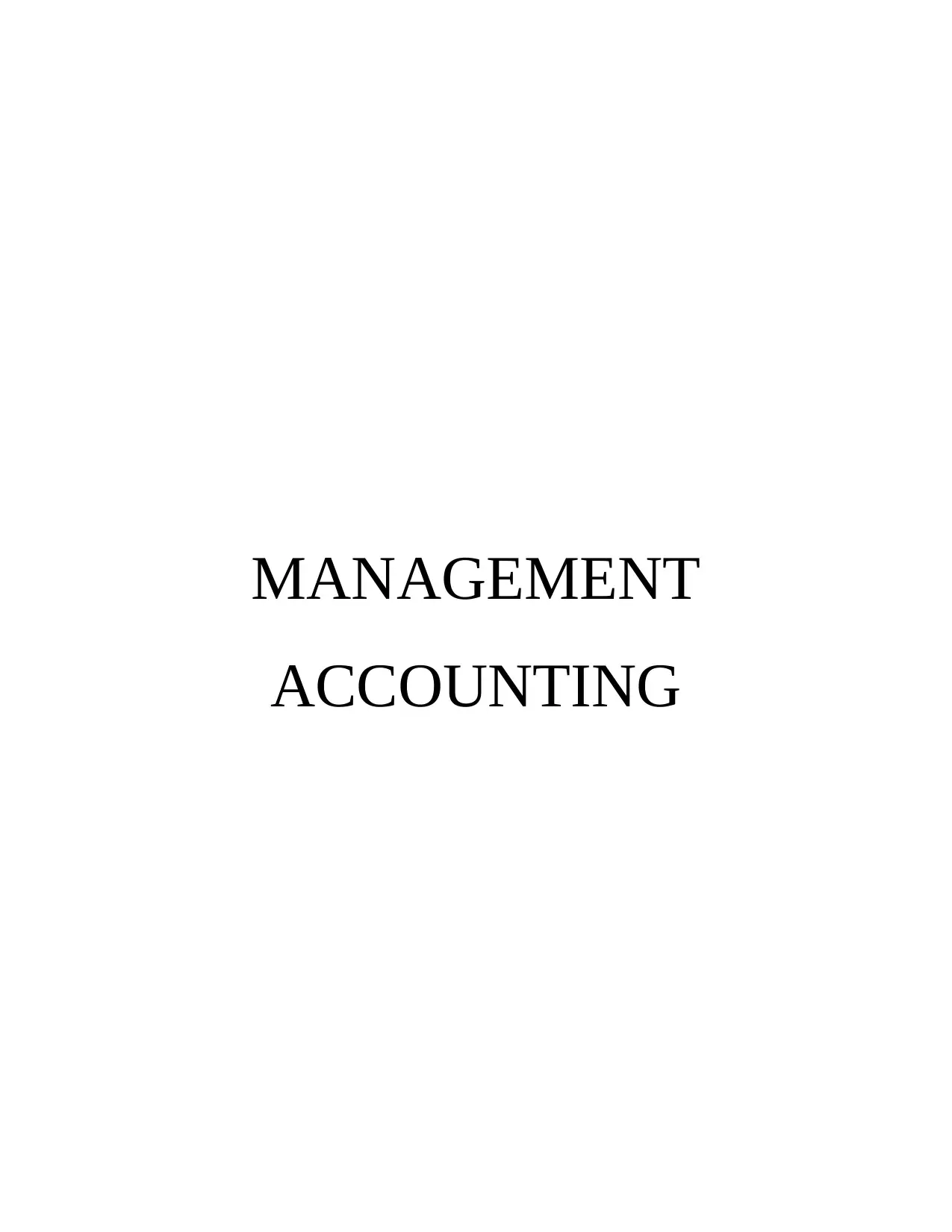
MANAGEMENT
ACCOUNTING
ACCOUNTING
Paraphrase This Document
Need a fresh take? Get an instant paraphrase of this document with our AI Paraphraser
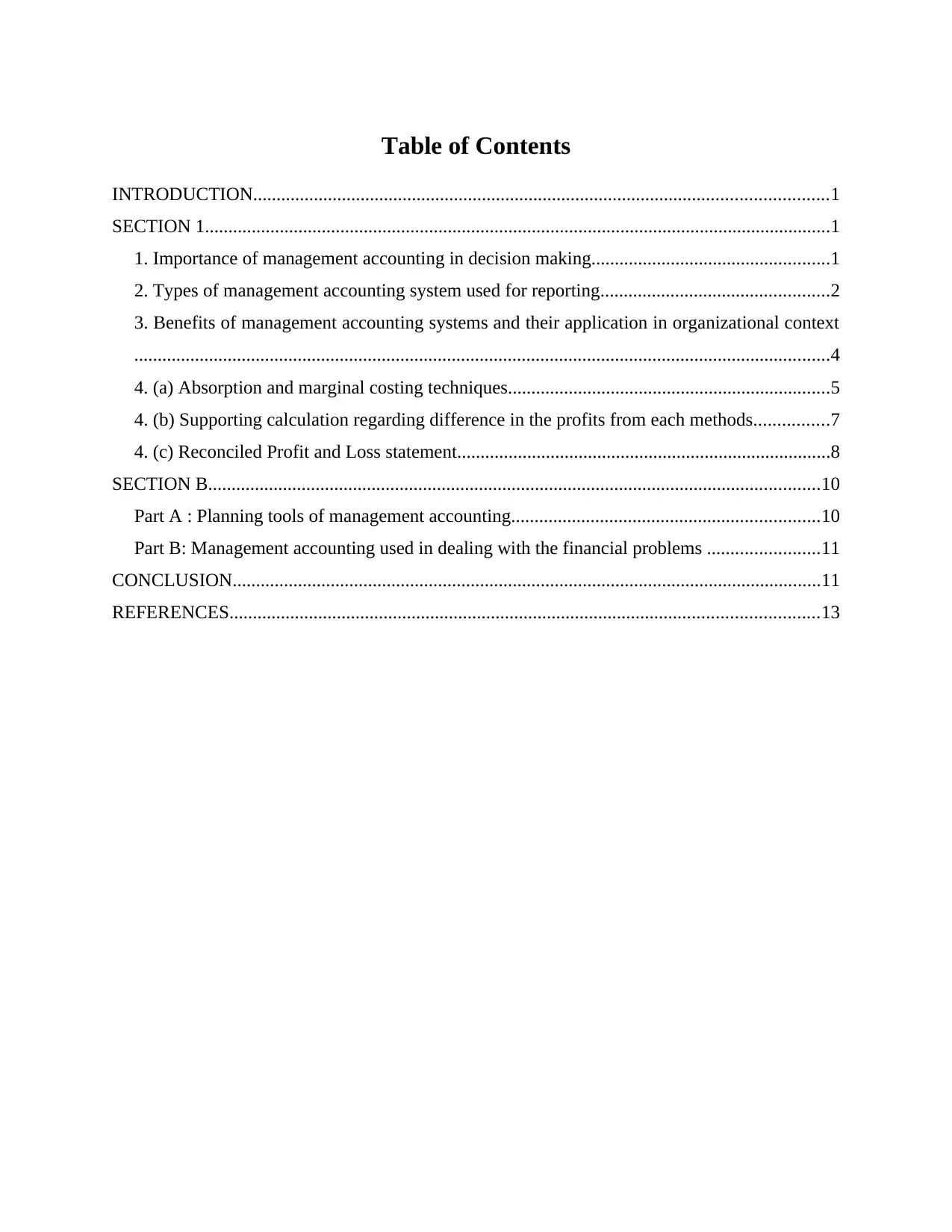
Table of Contents
INTRODUCTION...........................................................................................................................1
SECTION 1......................................................................................................................................1
1. Importance of management accounting in decision making...................................................1
2. Types of management accounting system used for reporting.................................................2
3. Benefits of management accounting systems and their application in organizational context
.....................................................................................................................................................4
4. (a) Absorption and marginal costing techniques.....................................................................5
4. (b) Supporting calculation regarding difference in the profits from each methods................7
4. (c) Reconciled Profit and Loss statement................................................................................8
SECTION B...................................................................................................................................10
Part A : Planning tools of management accounting..................................................................10
Part B: Management accounting used in dealing with the financial problems ........................11
CONCLUSION..............................................................................................................................11
REFERENCES..............................................................................................................................13
INTRODUCTION...........................................................................................................................1
SECTION 1......................................................................................................................................1
1. Importance of management accounting in decision making...................................................1
2. Types of management accounting system used for reporting.................................................2
3. Benefits of management accounting systems and their application in organizational context
.....................................................................................................................................................4
4. (a) Absorption and marginal costing techniques.....................................................................5
4. (b) Supporting calculation regarding difference in the profits from each methods................7
4. (c) Reconciled Profit and Loss statement................................................................................8
SECTION B...................................................................................................................................10
Part A : Planning tools of management accounting..................................................................10
Part B: Management accounting used in dealing with the financial problems ........................11
CONCLUSION..............................................................................................................................11
REFERENCES..............................................................................................................................13
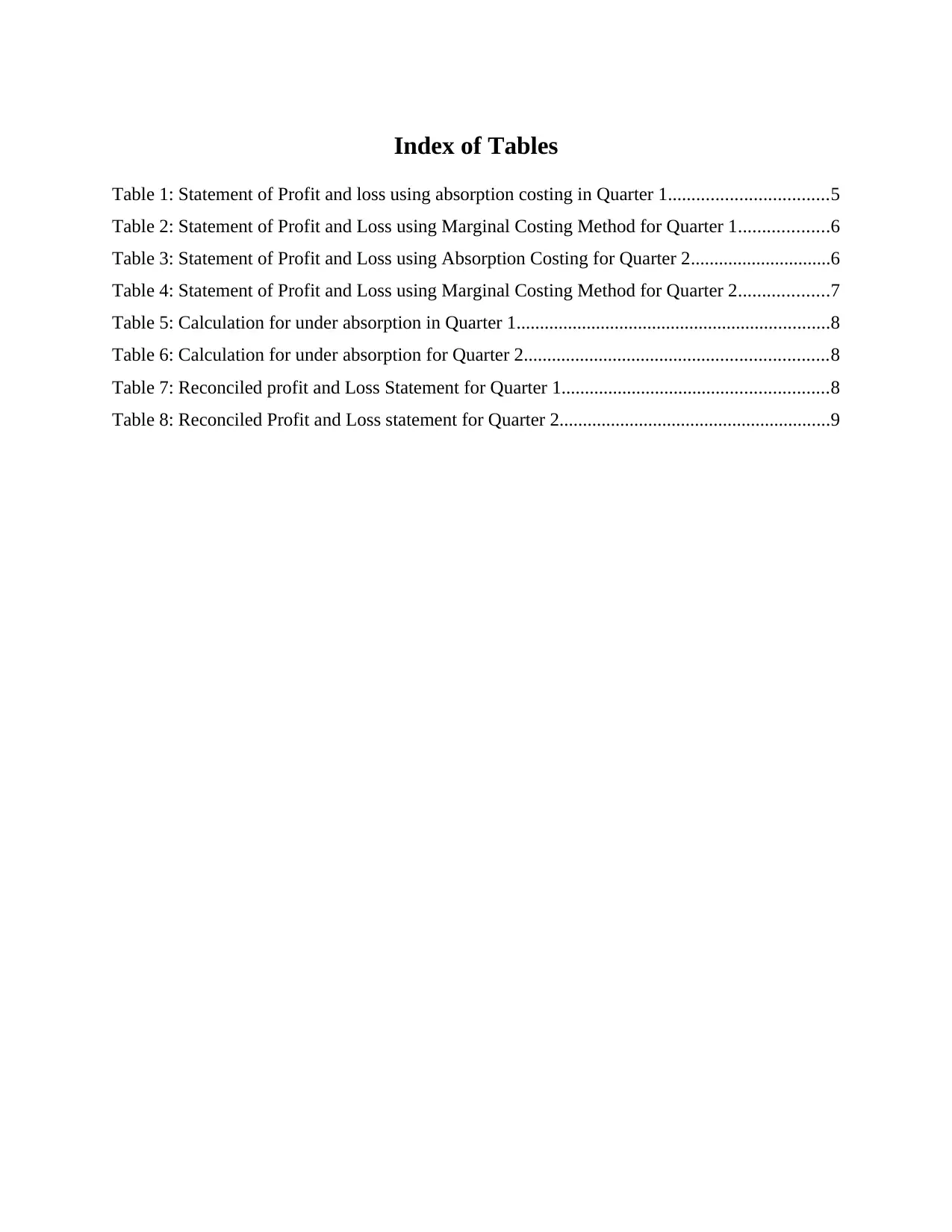
Index of Tables
Table 1: Statement of Profit and loss using absorption costing in Quarter 1..................................5
Table 2: Statement of Profit and Loss using Marginal Costing Method for Quarter 1...................6
Table 3: Statement of Profit and Loss using Absorption Costing for Quarter 2..............................6
Table 4: Statement of Profit and Loss using Marginal Costing Method for Quarter 2...................7
Table 5: Calculation for under absorption in Quarter 1...................................................................8
Table 6: Calculation for under absorption for Quarter 2.................................................................8
Table 7: Reconciled profit and Loss Statement for Quarter 1.........................................................8
Table 8: Reconciled Profit and Loss statement for Quarter 2..........................................................9
Table 1: Statement of Profit and loss using absorption costing in Quarter 1..................................5
Table 2: Statement of Profit and Loss using Marginal Costing Method for Quarter 1...................6
Table 3: Statement of Profit and Loss using Absorption Costing for Quarter 2..............................6
Table 4: Statement of Profit and Loss using Marginal Costing Method for Quarter 2...................7
Table 5: Calculation for under absorption in Quarter 1...................................................................8
Table 6: Calculation for under absorption for Quarter 2.................................................................8
Table 7: Reconciled profit and Loss Statement for Quarter 1.........................................................8
Table 8: Reconciled Profit and Loss statement for Quarter 2..........................................................9
⊘ This is a preview!⊘
Do you want full access?
Subscribe today to unlock all pages.

Trusted by 1+ million students worldwide
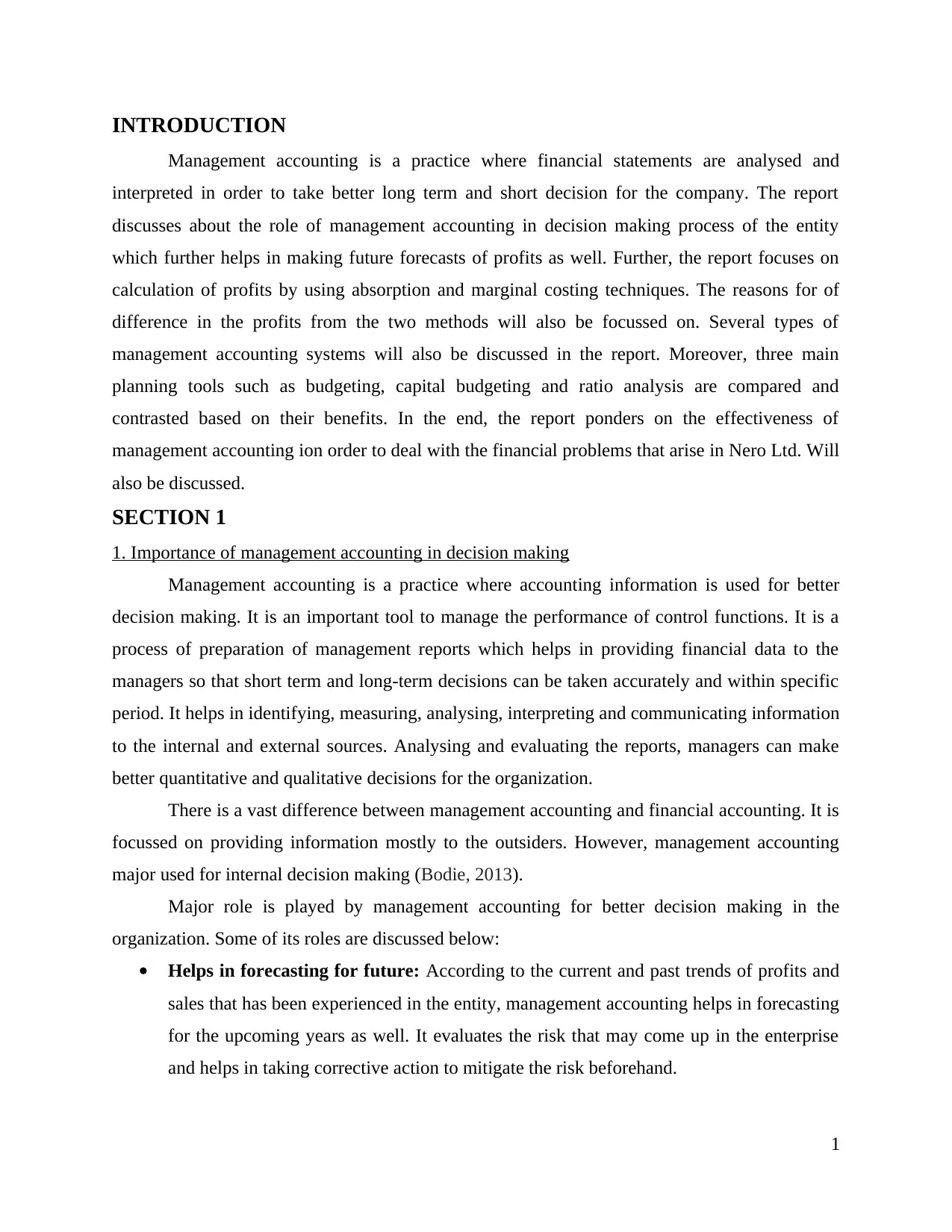
INTRODUCTION
Management accounting is a practice where financial statements are analysed and
interpreted in order to take better long term and short decision for the company. The report
discusses about the role of management accounting in decision making process of the entity
which further helps in making future forecasts of profits as well. Further, the report focuses on
calculation of profits by using absorption and marginal costing techniques. The reasons for of
difference in the profits from the two methods will also be focussed on. Several types of
management accounting systems will also be discussed in the report. Moreover, three main
planning tools such as budgeting, capital budgeting and ratio analysis are compared and
contrasted based on their benefits. In the end, the report ponders on the effectiveness of
management accounting ion order to deal with the financial problems that arise in Nero Ltd. Will
also be discussed.
SECTION 1
1. Importance of management accounting in decision making
Management accounting is a practice where accounting information is used for better
decision making. It is an important tool to manage the performance of control functions. It is a
process of preparation of management reports which helps in providing financial data to the
managers so that short term and long-term decisions can be taken accurately and within specific
period. It helps in identifying, measuring, analysing, interpreting and communicating information
to the internal and external sources. Analysing and evaluating the reports, managers can make
better quantitative and qualitative decisions for the organization.
There is a vast difference between management accounting and financial accounting. It is
focussed on providing information mostly to the outsiders. However, management accounting
major used for internal decision making (Bodie, 2013).
Major role is played by management accounting for better decision making in the
organization. Some of its roles are discussed below:
Helps in forecasting for future: According to the current and past trends of profits and
sales that has been experienced in the entity, management accounting helps in forecasting
for the upcoming years as well. It evaluates the risk that may come up in the enterprise
and helps in taking corrective action to mitigate the risk beforehand.
1
Management accounting is a practice where financial statements are analysed and
interpreted in order to take better long term and short decision for the company. The report
discusses about the role of management accounting in decision making process of the entity
which further helps in making future forecasts of profits as well. Further, the report focuses on
calculation of profits by using absorption and marginal costing techniques. The reasons for of
difference in the profits from the two methods will also be focussed on. Several types of
management accounting systems will also be discussed in the report. Moreover, three main
planning tools such as budgeting, capital budgeting and ratio analysis are compared and
contrasted based on their benefits. In the end, the report ponders on the effectiveness of
management accounting ion order to deal with the financial problems that arise in Nero Ltd. Will
also be discussed.
SECTION 1
1. Importance of management accounting in decision making
Management accounting is a practice where accounting information is used for better
decision making. It is an important tool to manage the performance of control functions. It is a
process of preparation of management reports which helps in providing financial data to the
managers so that short term and long-term decisions can be taken accurately and within specific
period. It helps in identifying, measuring, analysing, interpreting and communicating information
to the internal and external sources. Analysing and evaluating the reports, managers can make
better quantitative and qualitative decisions for the organization.
There is a vast difference between management accounting and financial accounting. It is
focussed on providing information mostly to the outsiders. However, management accounting
major used for internal decision making (Bodie, 2013).
Major role is played by management accounting for better decision making in the
organization. Some of its roles are discussed below:
Helps in forecasting for future: According to the current and past trends of profits and
sales that has been experienced in the entity, management accounting helps in forecasting
for the upcoming years as well. It evaluates the risk that may come up in the enterprise
and helps in taking corrective action to mitigate the risk beforehand.
1
Paraphrase This Document
Need a fresh take? Get an instant paraphrase of this document with our AI Paraphraser
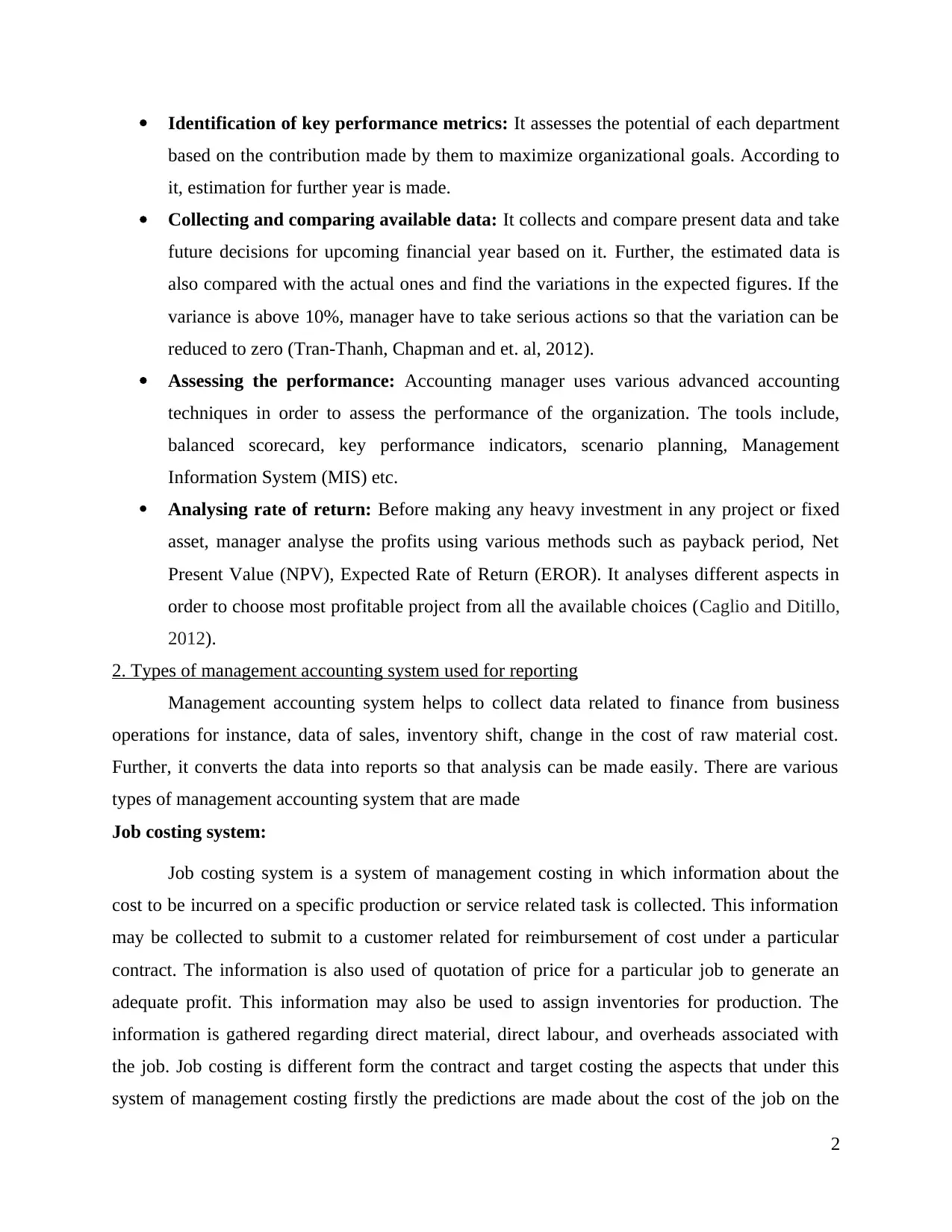
Identification of key performance metrics: It assesses the potential of each department
based on the contribution made by them to maximize organizational goals. According to
it, estimation for further year is made.
Collecting and comparing available data: It collects and compare present data and take
future decisions for upcoming financial year based on it. Further, the estimated data is
also compared with the actual ones and find the variations in the expected figures. If the
variance is above 10%, manager have to take serious actions so that the variation can be
reduced to zero (Tran-Thanh, Chapman and et. al, 2012).
Assessing the performance: Accounting manager uses various advanced accounting
techniques in order to assess the performance of the organization. The tools include,
balanced scorecard, key performance indicators, scenario planning, Management
Information System (MIS) etc.
Analysing rate of return: Before making any heavy investment in any project or fixed
asset, manager analyse the profits using various methods such as payback period, Net
Present Value (NPV), Expected Rate of Return (EROR). It analyses different aspects in
order to choose most profitable project from all the available choices (Caglio and Ditillo,
2012).
2. Types of management accounting system used for reporting
Management accounting system helps to collect data related to finance from business
operations for instance, data of sales, inventory shift, change in the cost of raw material cost.
Further, it converts the data into reports so that analysis can be made easily. There are various
types of management accounting system that are made
Job costing system:
Job costing system is a system of management costing in which information about the
cost to be incurred on a specific production or service related task is collected. This information
may be collected to submit to a customer related for reimbursement of cost under a particular
contract. The information is also used of quotation of price for a particular job to generate an
adequate profit. This information may also be used to assign inventories for production. The
information is gathered regarding direct material, direct labour, and overheads associated with
the job. Job costing is different form the contract and target costing the aspects that under this
system of management costing firstly the predictions are made about the cost of the job on the
2
based on the contribution made by them to maximize organizational goals. According to
it, estimation for further year is made.
Collecting and comparing available data: It collects and compare present data and take
future decisions for upcoming financial year based on it. Further, the estimated data is
also compared with the actual ones and find the variations in the expected figures. If the
variance is above 10%, manager have to take serious actions so that the variation can be
reduced to zero (Tran-Thanh, Chapman and et. al, 2012).
Assessing the performance: Accounting manager uses various advanced accounting
techniques in order to assess the performance of the organization. The tools include,
balanced scorecard, key performance indicators, scenario planning, Management
Information System (MIS) etc.
Analysing rate of return: Before making any heavy investment in any project or fixed
asset, manager analyse the profits using various methods such as payback period, Net
Present Value (NPV), Expected Rate of Return (EROR). It analyses different aspects in
order to choose most profitable project from all the available choices (Caglio and Ditillo,
2012).
2. Types of management accounting system used for reporting
Management accounting system helps to collect data related to finance from business
operations for instance, data of sales, inventory shift, change in the cost of raw material cost.
Further, it converts the data into reports so that analysis can be made easily. There are various
types of management accounting system that are made
Job costing system:
Job costing system is a system of management costing in which information about the
cost to be incurred on a specific production or service related task is collected. This information
may be collected to submit to a customer related for reimbursement of cost under a particular
contract. The information is also used of quotation of price for a particular job to generate an
adequate profit. This information may also be used to assign inventories for production. The
information is gathered regarding direct material, direct labour, and overheads associated with
the job. Job costing is different form the contract and target costing the aspects that under this
system of management costing firstly the predictions are made about the cost of the job on the
2
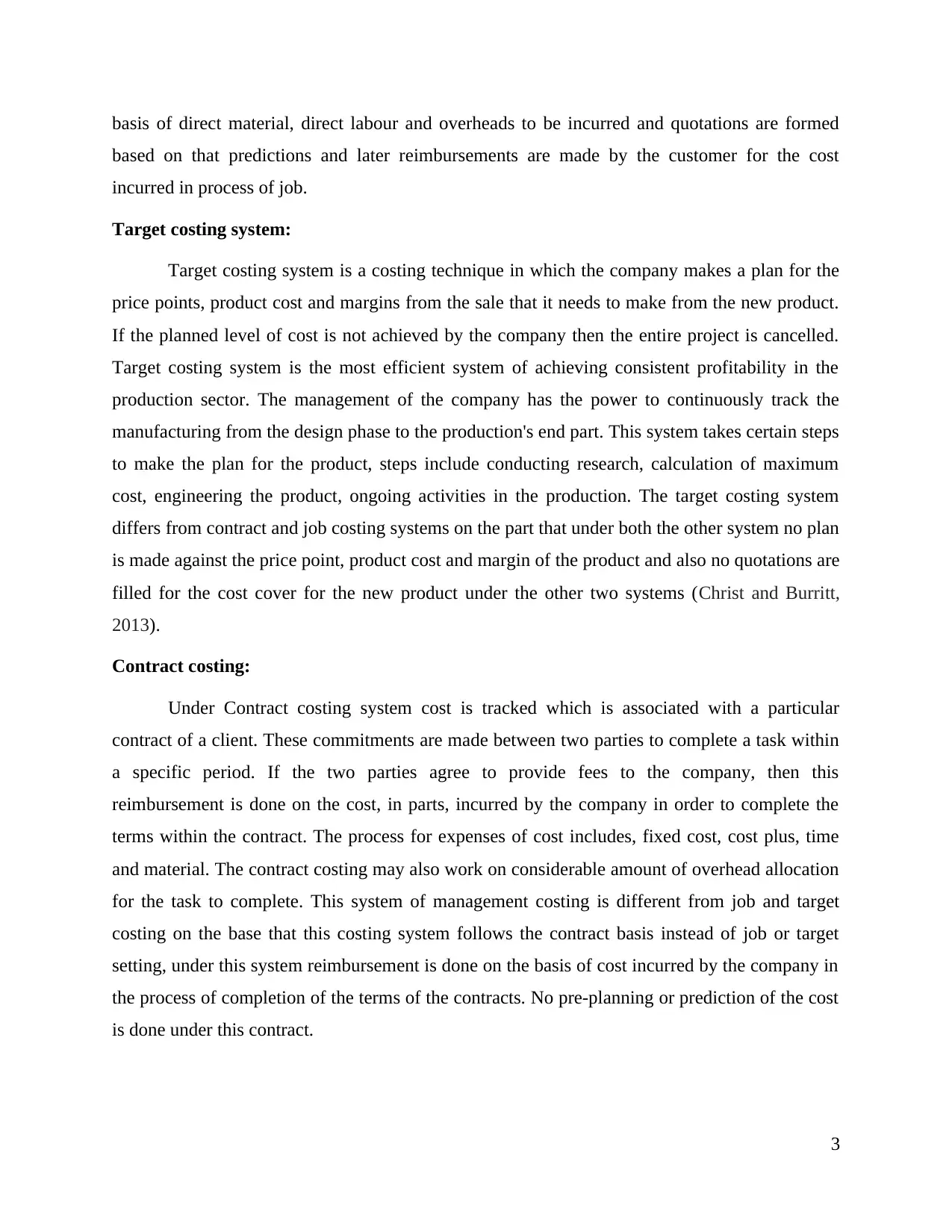
basis of direct material, direct labour and overheads to be incurred and quotations are formed
based on that predictions and later reimbursements are made by the customer for the cost
incurred in process of job.
Target costing system:
Target costing system is a costing technique in which the company makes a plan for the
price points, product cost and margins from the sale that it needs to make from the new product.
If the planned level of cost is not achieved by the company then the entire project is cancelled.
Target costing system is the most efficient system of achieving consistent profitability in the
production sector. The management of the company has the power to continuously track the
manufacturing from the design phase to the production's end part. This system takes certain steps
to make the plan for the product, steps include conducting research, calculation of maximum
cost, engineering the product, ongoing activities in the production. The target costing system
differs from contract and job costing systems on the part that under both the other system no plan
is made against the price point, product cost and margin of the product and also no quotations are
filled for the cost cover for the new product under the other two systems (Christ and Burritt,
2013).
Contract costing:
Under Contract costing system cost is tracked which is associated with a particular
contract of a client. These commitments are made between two parties to complete a task within
a specific period. If the two parties agree to provide fees to the company, then this
reimbursement is done on the cost, in parts, incurred by the company in order to complete the
terms within the contract. The process for expenses of cost includes, fixed cost, cost plus, time
and material. The contract costing may also work on considerable amount of overhead allocation
for the task to complete. This system of management costing is different from job and target
costing on the base that this costing system follows the contract basis instead of job or target
setting, under this system reimbursement is done on the basis of cost incurred by the company in
the process of completion of the terms of the contracts. No pre-planning or prediction of the cost
is done under this contract.
3
based on that predictions and later reimbursements are made by the customer for the cost
incurred in process of job.
Target costing system:
Target costing system is a costing technique in which the company makes a plan for the
price points, product cost and margins from the sale that it needs to make from the new product.
If the planned level of cost is not achieved by the company then the entire project is cancelled.
Target costing system is the most efficient system of achieving consistent profitability in the
production sector. The management of the company has the power to continuously track the
manufacturing from the design phase to the production's end part. This system takes certain steps
to make the plan for the product, steps include conducting research, calculation of maximum
cost, engineering the product, ongoing activities in the production. The target costing system
differs from contract and job costing systems on the part that under both the other system no plan
is made against the price point, product cost and margin of the product and also no quotations are
filled for the cost cover for the new product under the other two systems (Christ and Burritt,
2013).
Contract costing:
Under Contract costing system cost is tracked which is associated with a particular
contract of a client. These commitments are made between two parties to complete a task within
a specific period. If the two parties agree to provide fees to the company, then this
reimbursement is done on the cost, in parts, incurred by the company in order to complete the
terms within the contract. The process for expenses of cost includes, fixed cost, cost plus, time
and material. The contract costing may also work on considerable amount of overhead allocation
for the task to complete. This system of management costing is different from job and target
costing on the base that this costing system follows the contract basis instead of job or target
setting, under this system reimbursement is done on the basis of cost incurred by the company in
the process of completion of the terms of the contracts. No pre-planning or prediction of the cost
is done under this contract.
3
⊘ This is a preview!⊘
Do you want full access?
Subscribe today to unlock all pages.

Trusted by 1+ million students worldwide
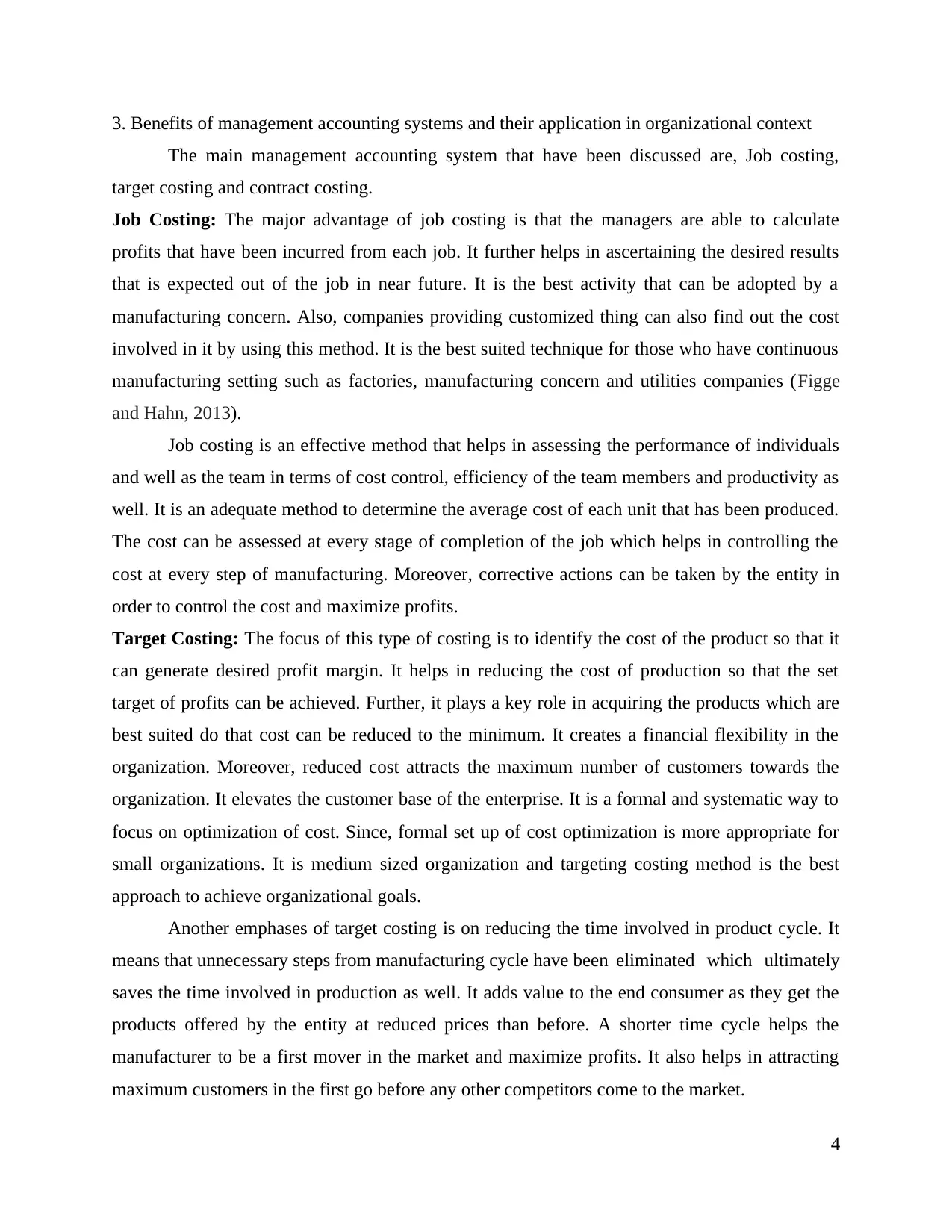
3. Benefits of management accounting systems and their application in organizational context
The main management accounting system that have been discussed are, Job costing,
target costing and contract costing.
Job Costing: The major advantage of job costing is that the managers are able to calculate
profits that have been incurred from each job. It further helps in ascertaining the desired results
that is expected out of the job in near future. It is the best activity that can be adopted by a
manufacturing concern. Also, companies providing customized thing can also find out the cost
involved in it by using this method. It is the best suited technique for those who have continuous
manufacturing setting such as factories, manufacturing concern and utilities companies (Figge
and Hahn, 2013).
Job costing is an effective method that helps in assessing the performance of individuals
and well as the team in terms of cost control, efficiency of the team members and productivity as
well. It is an adequate method to determine the average cost of each unit that has been produced.
The cost can be assessed at every stage of completion of the job which helps in controlling the
cost at every step of manufacturing. Moreover, corrective actions can be taken by the entity in
order to control the cost and maximize profits.
Target Costing: The focus of this type of costing is to identify the cost of the product so that it
can generate desired profit margin. It helps in reducing the cost of production so that the set
target of profits can be achieved. Further, it plays a key role in acquiring the products which are
best suited do that cost can be reduced to the minimum. It creates a financial flexibility in the
organization. Moreover, reduced cost attracts the maximum number of customers towards the
organization. It elevates the customer base of the enterprise. It is a formal and systematic way to
focus on optimization of cost. Since, formal set up of cost optimization is more appropriate for
small organizations. It is medium sized organization and targeting costing method is the best
approach to achieve organizational goals.
Another emphases of target costing is on reducing the time involved in product cycle. It
means that unnecessary steps from manufacturing cycle have been eliminated which ultimately
saves the time involved in production as well. It adds value to the end consumer as they get the
products offered by the entity at reduced prices than before. A shorter time cycle helps the
manufacturer to be a first mover in the market and maximize profits. It also helps in attracting
maximum customers in the first go before any other competitors come to the market.
4
The main management accounting system that have been discussed are, Job costing,
target costing and contract costing.
Job Costing: The major advantage of job costing is that the managers are able to calculate
profits that have been incurred from each job. It further helps in ascertaining the desired results
that is expected out of the job in near future. It is the best activity that can be adopted by a
manufacturing concern. Also, companies providing customized thing can also find out the cost
involved in it by using this method. It is the best suited technique for those who have continuous
manufacturing setting such as factories, manufacturing concern and utilities companies (Figge
and Hahn, 2013).
Job costing is an effective method that helps in assessing the performance of individuals
and well as the team in terms of cost control, efficiency of the team members and productivity as
well. It is an adequate method to determine the average cost of each unit that has been produced.
The cost can be assessed at every stage of completion of the job which helps in controlling the
cost at every step of manufacturing. Moreover, corrective actions can be taken by the entity in
order to control the cost and maximize profits.
Target Costing: The focus of this type of costing is to identify the cost of the product so that it
can generate desired profit margin. It helps in reducing the cost of production so that the set
target of profits can be achieved. Further, it plays a key role in acquiring the products which are
best suited do that cost can be reduced to the minimum. It creates a financial flexibility in the
organization. Moreover, reduced cost attracts the maximum number of customers towards the
organization. It elevates the customer base of the enterprise. It is a formal and systematic way to
focus on optimization of cost. Since, formal set up of cost optimization is more appropriate for
small organizations. It is medium sized organization and targeting costing method is the best
approach to achieve organizational goals.
Another emphases of target costing is on reducing the time involved in product cycle. It
means that unnecessary steps from manufacturing cycle have been eliminated which ultimately
saves the time involved in production as well. It adds value to the end consumer as they get the
products offered by the entity at reduced prices than before. A shorter time cycle helps the
manufacturer to be a first mover in the market and maximize profits. It also helps in attracting
maximum customers in the first go before any other competitors come to the market.
4
Paraphrase This Document
Need a fresh take? Get an instant paraphrase of this document with our AI Paraphraser
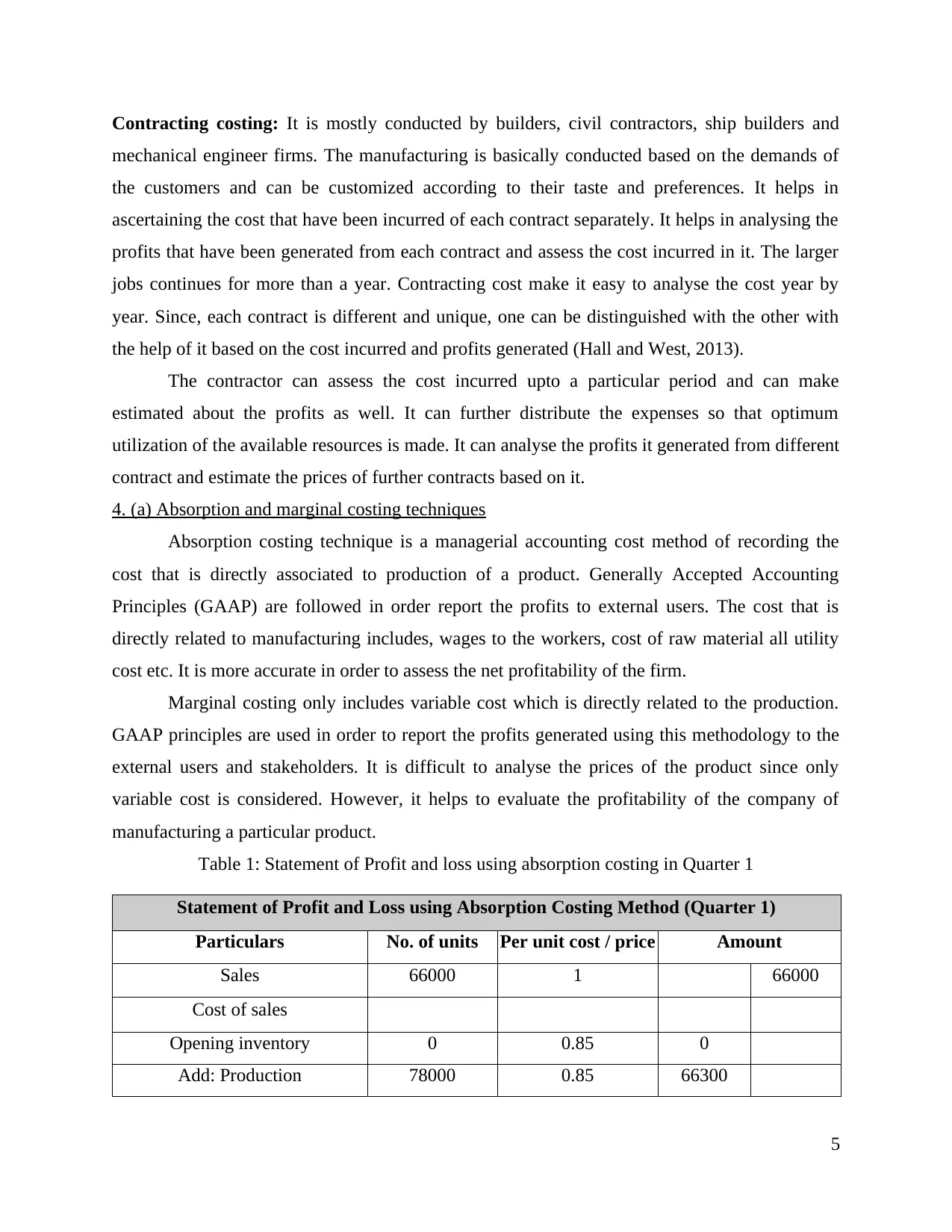
Contracting costing: It is mostly conducted by builders, civil contractors, ship builders and
mechanical engineer firms. The manufacturing is basically conducted based on the demands of
the customers and can be customized according to their taste and preferences. It helps in
ascertaining the cost that have been incurred of each contract separately. It helps in analysing the
profits that have been generated from each contract and assess the cost incurred in it. The larger
jobs continues for more than a year. Contracting cost make it easy to analyse the cost year by
year. Since, each contract is different and unique, one can be distinguished with the other with
the help of it based on the cost incurred and profits generated (Hall and West, 2013).
The contractor can assess the cost incurred upto a particular period and can make
estimated about the profits as well. It can further distribute the expenses so that optimum
utilization of the available resources is made. It can analyse the profits it generated from different
contract and estimate the prices of further contracts based on it.
4. (a) Absorption and marginal costing techniques
Absorption costing technique is a managerial accounting cost method of recording the
cost that is directly associated to production of a product. Generally Accepted Accounting
Principles (GAAP) are followed in order report the profits to external users. The cost that is
directly related to manufacturing includes, wages to the workers, cost of raw material all utility
cost etc. It is more accurate in order to assess the net profitability of the firm.
Marginal costing only includes variable cost which is directly related to the production.
GAAP principles are used in order to report the profits generated using this methodology to the
external users and stakeholders. It is difficult to analyse the prices of the product since only
variable cost is considered. However, it helps to evaluate the profitability of the company of
manufacturing a particular product.
Table 1: Statement of Profit and loss using absorption costing in Quarter 1
Statement of Profit and Loss using Absorption Costing Method (Quarter 1)
Particulars No. of units Per unit cost / price Amount
Sales 66000 1 66000
Cost of sales
Opening inventory 0 0.85 0
Add: Production 78000 0.85 66300
5
mechanical engineer firms. The manufacturing is basically conducted based on the demands of
the customers and can be customized according to their taste and preferences. It helps in
ascertaining the cost that have been incurred of each contract separately. It helps in analysing the
profits that have been generated from each contract and assess the cost incurred in it. The larger
jobs continues for more than a year. Contracting cost make it easy to analyse the cost year by
year. Since, each contract is different and unique, one can be distinguished with the other with
the help of it based on the cost incurred and profits generated (Hall and West, 2013).
The contractor can assess the cost incurred upto a particular period and can make
estimated about the profits as well. It can further distribute the expenses so that optimum
utilization of the available resources is made. It can analyse the profits it generated from different
contract and estimate the prices of further contracts based on it.
4. (a) Absorption and marginal costing techniques
Absorption costing technique is a managerial accounting cost method of recording the
cost that is directly associated to production of a product. Generally Accepted Accounting
Principles (GAAP) are followed in order report the profits to external users. The cost that is
directly related to manufacturing includes, wages to the workers, cost of raw material all utility
cost etc. It is more accurate in order to assess the net profitability of the firm.
Marginal costing only includes variable cost which is directly related to the production.
GAAP principles are used in order to report the profits generated using this methodology to the
external users and stakeholders. It is difficult to analyse the prices of the product since only
variable cost is considered. However, it helps to evaluate the profitability of the company of
manufacturing a particular product.
Table 1: Statement of Profit and loss using absorption costing in Quarter 1
Statement of Profit and Loss using Absorption Costing Method (Quarter 1)
Particulars No. of units Per unit cost / price Amount
Sales 66000 1 66000
Cost of sales
Opening inventory 0 0.85 0
Add: Production 78000 0.85 66300
5
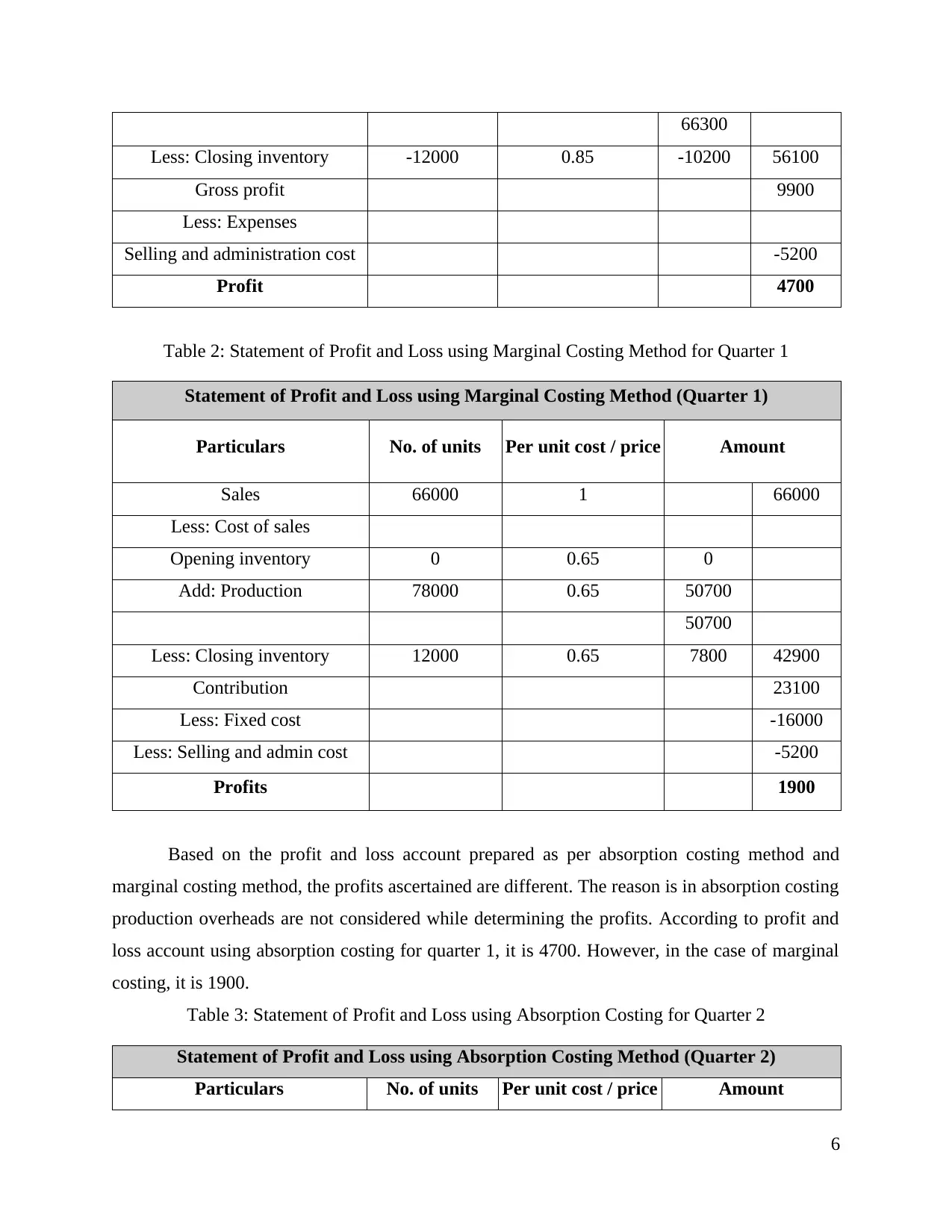
66300
Less: Closing inventory -12000 0.85 -10200 56100
Gross profit 9900
Less: Expenses
Selling and administration cost -5200
Profit 4700
Table 2: Statement of Profit and Loss using Marginal Costing Method for Quarter 1
Statement of Profit and Loss using Marginal Costing Method (Quarter 1)
Particulars No. of units Per unit cost / price Amount
Sales 66000 1 66000
Less: Cost of sales
Opening inventory 0 0.65 0
Add: Production 78000 0.65 50700
50700
Less: Closing inventory 12000 0.65 7800 42900
Contribution 23100
Less: Fixed cost -16000
Less: Selling and admin cost -5200
Profits 1900
Based on the profit and loss account prepared as per absorption costing method and
marginal costing method, the profits ascertained are different. The reason is in absorption costing
production overheads are not considered while determining the profits. According to profit and
loss account using absorption costing for quarter 1, it is 4700. However, in the case of marginal
costing, it is 1900.
Table 3: Statement of Profit and Loss using Absorption Costing for Quarter 2
Statement of Profit and Loss using Absorption Costing Method (Quarter 2)
Particulars No. of units Per unit cost / price Amount
6
Less: Closing inventory -12000 0.85 -10200 56100
Gross profit 9900
Less: Expenses
Selling and administration cost -5200
Profit 4700
Table 2: Statement of Profit and Loss using Marginal Costing Method for Quarter 1
Statement of Profit and Loss using Marginal Costing Method (Quarter 1)
Particulars No. of units Per unit cost / price Amount
Sales 66000 1 66000
Less: Cost of sales
Opening inventory 0 0.65 0
Add: Production 78000 0.65 50700
50700
Less: Closing inventory 12000 0.65 7800 42900
Contribution 23100
Less: Fixed cost -16000
Less: Selling and admin cost -5200
Profits 1900
Based on the profit and loss account prepared as per absorption costing method and
marginal costing method, the profits ascertained are different. The reason is in absorption costing
production overheads are not considered while determining the profits. According to profit and
loss account using absorption costing for quarter 1, it is 4700. However, in the case of marginal
costing, it is 1900.
Table 3: Statement of Profit and Loss using Absorption Costing for Quarter 2
Statement of Profit and Loss using Absorption Costing Method (Quarter 2)
Particulars No. of units Per unit cost / price Amount
6
⊘ This is a preview!⊘
Do you want full access?
Subscribe today to unlock all pages.

Trusted by 1+ million students worldwide
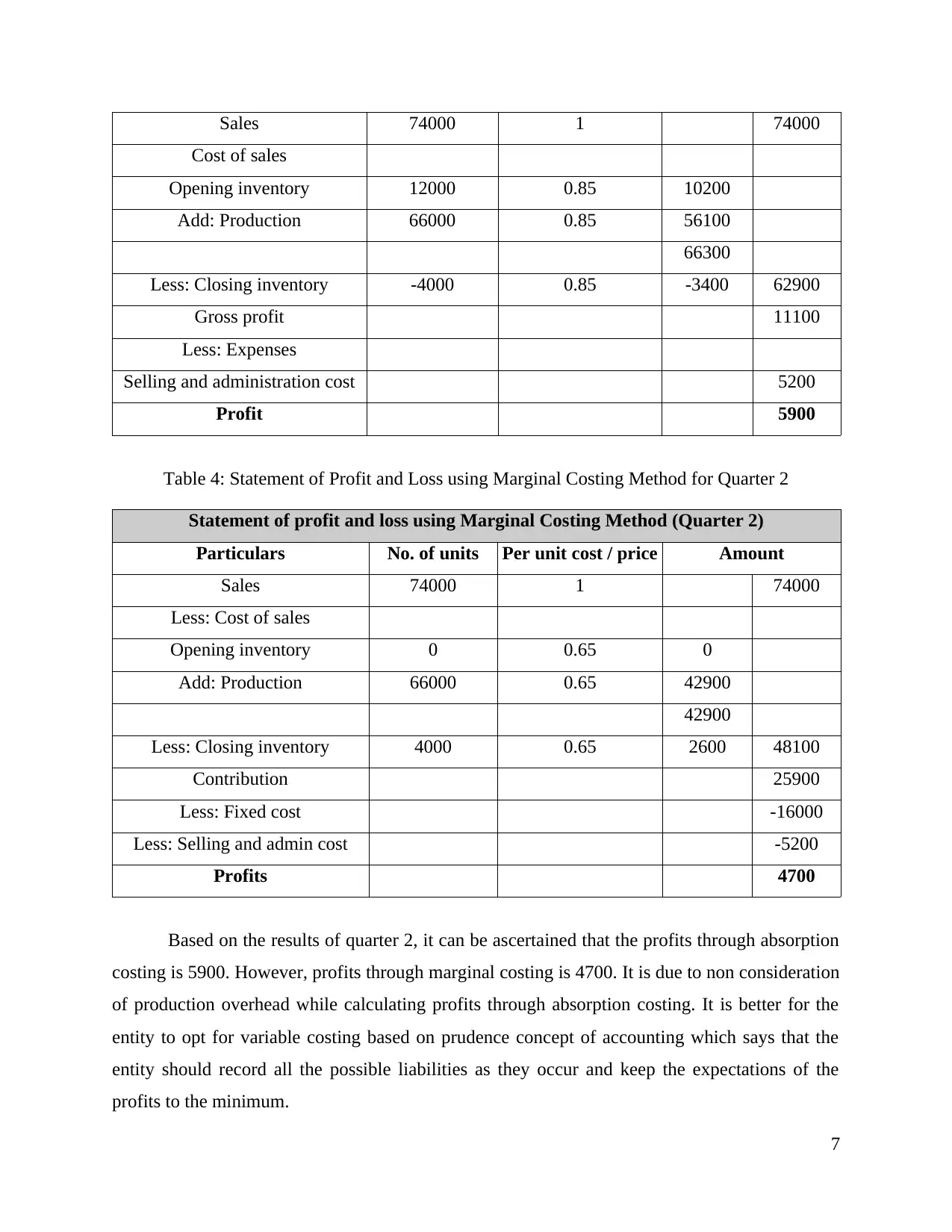
Sales 74000 1 74000
Cost of sales
Opening inventory 12000 0.85 10200
Add: Production 66000 0.85 56100
66300
Less: Closing inventory -4000 0.85 -3400 62900
Gross profit 11100
Less: Expenses
Selling and administration cost 5200
Profit 5900
Table 4: Statement of Profit and Loss using Marginal Costing Method for Quarter 2
Statement of profit and loss using Marginal Costing Method (Quarter 2)
Particulars No. of units Per unit cost / price Amount
Sales 74000 1 74000
Less: Cost of sales
Opening inventory 0 0.65 0
Add: Production 66000 0.65 42900
42900
Less: Closing inventory 4000 0.65 2600 48100
Contribution 25900
Less: Fixed cost -16000
Less: Selling and admin cost -5200
Profits 4700
Based on the results of quarter 2, it can be ascertained that the profits through absorption
costing is 5900. However, profits through marginal costing is 4700. It is due to non consideration
of production overhead while calculating profits through absorption costing. It is better for the
entity to opt for variable costing based on prudence concept of accounting which says that the
entity should record all the possible liabilities as they occur and keep the expectations of the
profits to the minimum.
7
Cost of sales
Opening inventory 12000 0.85 10200
Add: Production 66000 0.85 56100
66300
Less: Closing inventory -4000 0.85 -3400 62900
Gross profit 11100
Less: Expenses
Selling and administration cost 5200
Profit 5900
Table 4: Statement of Profit and Loss using Marginal Costing Method for Quarter 2
Statement of profit and loss using Marginal Costing Method (Quarter 2)
Particulars No. of units Per unit cost / price Amount
Sales 74000 1 74000
Less: Cost of sales
Opening inventory 0 0.65 0
Add: Production 66000 0.65 42900
42900
Less: Closing inventory 4000 0.65 2600 48100
Contribution 25900
Less: Fixed cost -16000
Less: Selling and admin cost -5200
Profits 4700
Based on the results of quarter 2, it can be ascertained that the profits through absorption
costing is 5900. However, profits through marginal costing is 4700. It is due to non consideration
of production overhead while calculating profits through absorption costing. It is better for the
entity to opt for variable costing based on prudence concept of accounting which says that the
entity should record all the possible liabilities as they occur and keep the expectations of the
profits to the minimum.
7
Paraphrase This Document
Need a fresh take? Get an instant paraphrase of this document with our AI Paraphraser
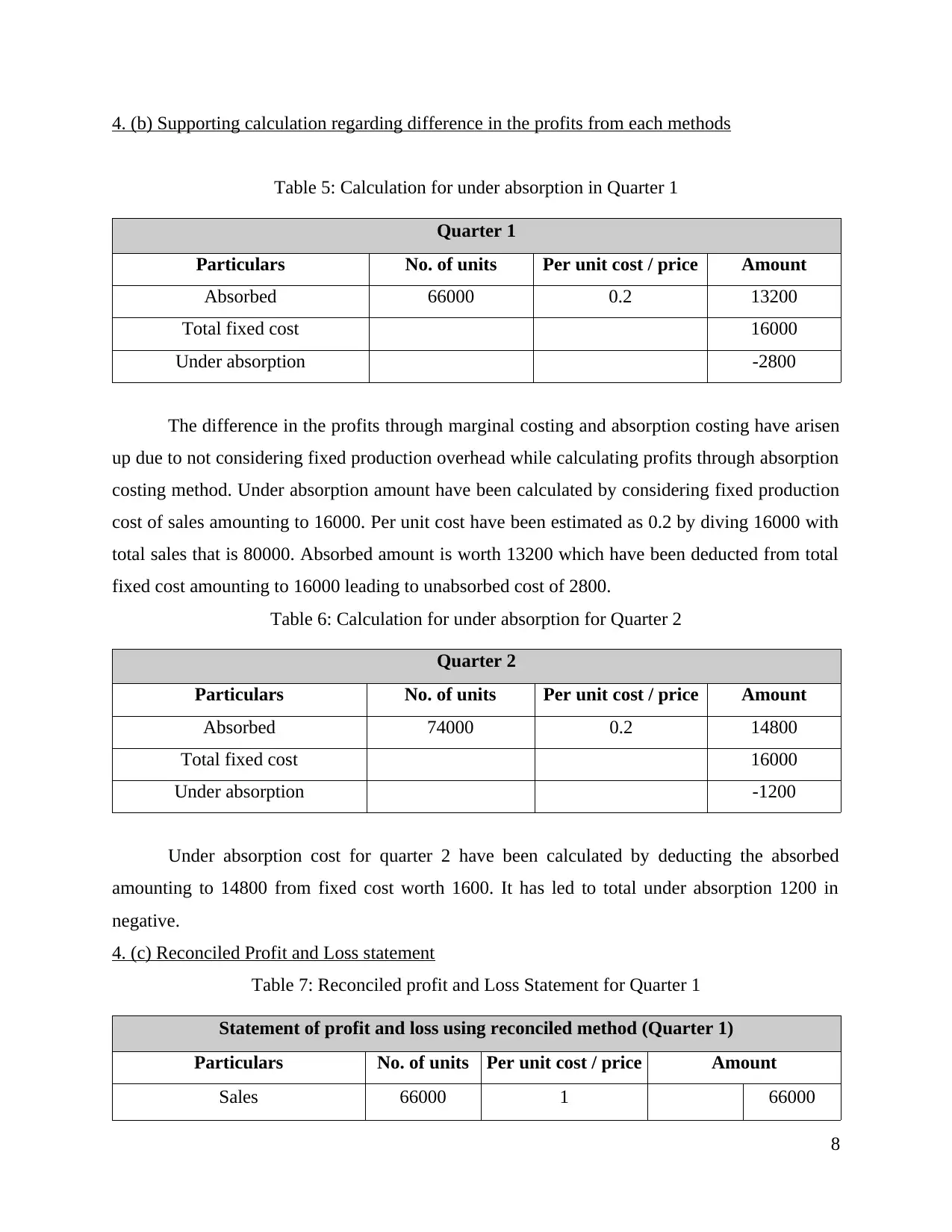
4. (b) Supporting calculation regarding difference in the profits from each methods
Table 5: Calculation for under absorption in Quarter 1
Quarter 1
Particulars No. of units Per unit cost / price Amount
Absorbed 66000 0.2 13200
Total fixed cost 16000
Under absorption -2800
The difference in the profits through marginal costing and absorption costing have arisen
up due to not considering fixed production overhead while calculating profits through absorption
costing method. Under absorption amount have been calculated by considering fixed production
cost of sales amounting to 16000. Per unit cost have been estimated as 0.2 by diving 16000 with
total sales that is 80000. Absorbed amount is worth 13200 which have been deducted from total
fixed cost amounting to 16000 leading to unabsorbed cost of 2800.
Table 6: Calculation for under absorption for Quarter 2
Quarter 2
Particulars No. of units Per unit cost / price Amount
Absorbed 74000 0.2 14800
Total fixed cost 16000
Under absorption -1200
Under absorption cost for quarter 2 have been calculated by deducting the absorbed
amounting to 14800 from fixed cost worth 1600. It has led to total under absorption 1200 in
negative.
4. (c) Reconciled Profit and Loss statement
Table 7: Reconciled profit and Loss Statement for Quarter 1
Statement of profit and loss using reconciled method (Quarter 1)
Particulars No. of units Per unit cost / price Amount
Sales 66000 1 66000
8
Table 5: Calculation for under absorption in Quarter 1
Quarter 1
Particulars No. of units Per unit cost / price Amount
Absorbed 66000 0.2 13200
Total fixed cost 16000
Under absorption -2800
The difference in the profits through marginal costing and absorption costing have arisen
up due to not considering fixed production overhead while calculating profits through absorption
costing method. Under absorption amount have been calculated by considering fixed production
cost of sales amounting to 16000. Per unit cost have been estimated as 0.2 by diving 16000 with
total sales that is 80000. Absorbed amount is worth 13200 which have been deducted from total
fixed cost amounting to 16000 leading to unabsorbed cost of 2800.
Table 6: Calculation for under absorption for Quarter 2
Quarter 2
Particulars No. of units Per unit cost / price Amount
Absorbed 74000 0.2 14800
Total fixed cost 16000
Under absorption -1200
Under absorption cost for quarter 2 have been calculated by deducting the absorbed
amounting to 14800 from fixed cost worth 1600. It has led to total under absorption 1200 in
negative.
4. (c) Reconciled Profit and Loss statement
Table 7: Reconciled profit and Loss Statement for Quarter 1
Statement of profit and loss using reconciled method (Quarter 1)
Particulars No. of units Per unit cost / price Amount
Sales 66000 1 66000
8
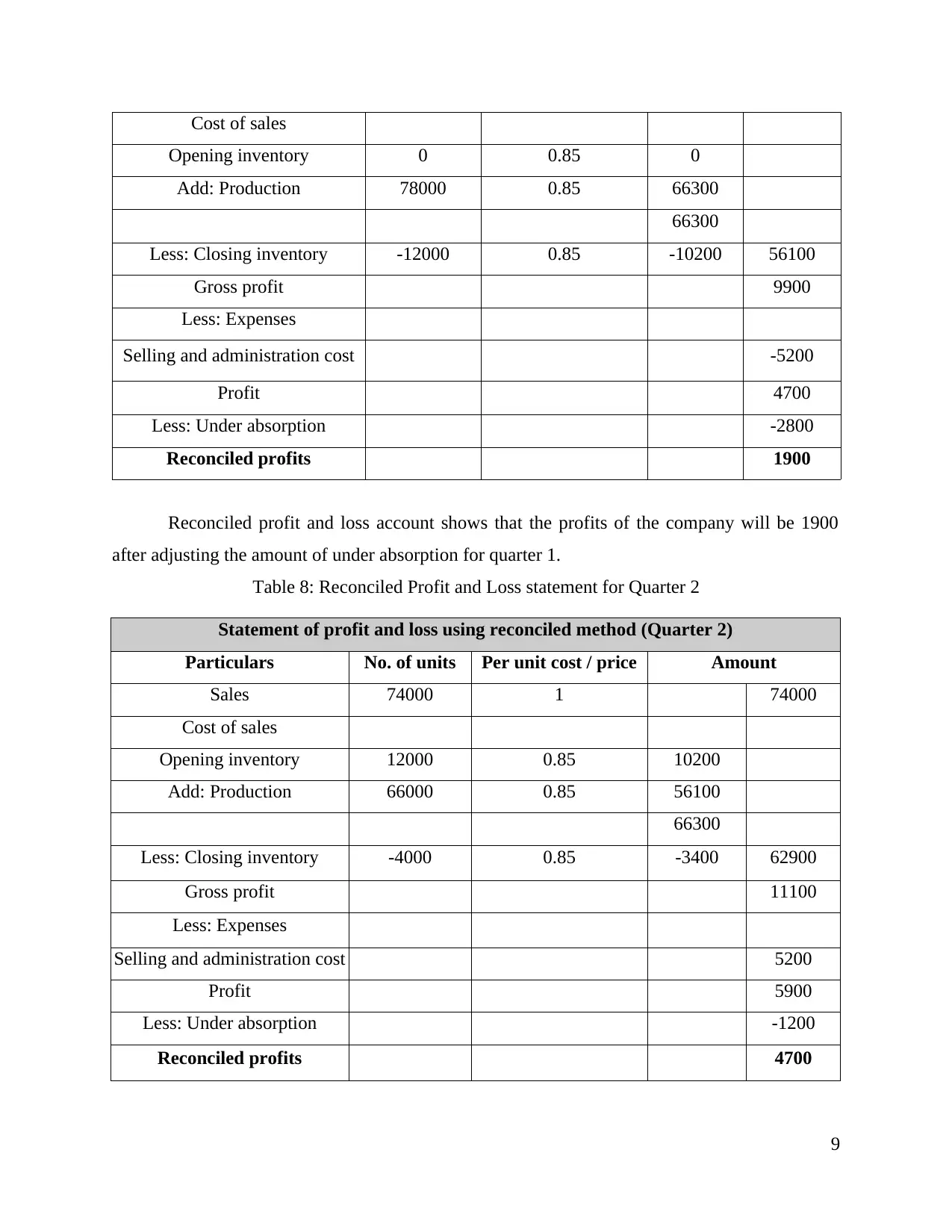
Cost of sales
Opening inventory 0 0.85 0
Add: Production 78000 0.85 66300
66300
Less: Closing inventory -12000 0.85 -10200 56100
Gross profit 9900
Less: Expenses
Selling and administration cost -5200
Profit 4700
Less: Under absorption -2800
Reconciled profits 1900
Reconciled profit and loss account shows that the profits of the company will be 1900
after adjusting the amount of under absorption for quarter 1.
Table 8: Reconciled Profit and Loss statement for Quarter 2
Statement of profit and loss using reconciled method (Quarter 2)
Particulars No. of units Per unit cost / price Amount
Sales 74000 1 74000
Cost of sales
Opening inventory 12000 0.85 10200
Add: Production 66000 0.85 56100
66300
Less: Closing inventory -4000 0.85 -3400 62900
Gross profit 11100
Less: Expenses
Selling and administration cost 5200
Profit 5900
Less: Under absorption -1200
Reconciled profits 4700
9
Opening inventory 0 0.85 0
Add: Production 78000 0.85 66300
66300
Less: Closing inventory -12000 0.85 -10200 56100
Gross profit 9900
Less: Expenses
Selling and administration cost -5200
Profit 4700
Less: Under absorption -2800
Reconciled profits 1900
Reconciled profit and loss account shows that the profits of the company will be 1900
after adjusting the amount of under absorption for quarter 1.
Table 8: Reconciled Profit and Loss statement for Quarter 2
Statement of profit and loss using reconciled method (Quarter 2)
Particulars No. of units Per unit cost / price Amount
Sales 74000 1 74000
Cost of sales
Opening inventory 12000 0.85 10200
Add: Production 66000 0.85 56100
66300
Less: Closing inventory -4000 0.85 -3400 62900
Gross profit 11100
Less: Expenses
Selling and administration cost 5200
Profit 5900
Less: Under absorption -1200
Reconciled profits 4700
9
⊘ This is a preview!⊘
Do you want full access?
Subscribe today to unlock all pages.

Trusted by 1+ million students worldwide
1 out of 17
Related Documents
Your All-in-One AI-Powered Toolkit for Academic Success.
+13062052269
info@desklib.com
Available 24*7 on WhatsApp / Email
![[object Object]](/_next/static/media/star-bottom.7253800d.svg)
Unlock your academic potential
Copyright © 2020–2025 A2Z Services. All Rights Reserved. Developed and managed by ZUCOL.





